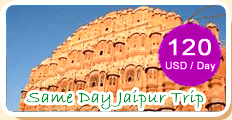
Agra Tour

Agra is a medieval city situated on the banks of the river Yamuna. It is generally accepted that Sultan Sikandar Lodi, the Ruler of Delhi Sultanate founded it in the year 1504. After the sultan's death the city passed on to his son Sultan Ibrahim Lodi. He ruled his Sultanate from Agra until he fell fighting to Babur in the First battle of Panipat fought in 1526.
In the year 1556, the great Hindu warrior, Hemu Vikramaditya also known as Hem Chander Vikramaditya won Agra as Prime Minister cum Chief of Army of Adil Shah of Afgan Sur Dynasty. The commander of Humayun / Akbar's forces in Agra was so scared of Hemu that he ran away from Agra without the fight. This was Hemu's 21st continuous win, who later on won Delhi also and had his coronation at Purana Qila in Delhi and re-established his Kingdom and the Vikramaditya Dynasty in North India.
TAJ MAHAL
The Taj Mahal is a mausoleum located in Agra, India, built by Mughal Emperor Shah Jahan in memory of his favorite wife, Mumtaz Mahal. The Taj Mahal (also "the Taj") is considered the finest example of Mughal architecture, a style that combines elements from Persian, Indian, and Islamic architectural styles. In 1983, the Taj Mahal became a UNESCO World Heritage Site and was cited as "the jewel of Muslim art in India and one of the universally admired masterpieces of the world's heritage."
AGRA FORT
Agra Fort is a UNESCO World Heritage site located in Agra, India. The fort is also known as Lal Qila, Fort Rouge and Red Fort of Agra. It is about 2.5 km northwest of its much more famous sister monument, the Taj Mahal. The fort can be more accurately described as a walled palatial city. It is the most important fort in India. The great Mughals Babur, Humayun, Akbar, Jehangir, Shah Jahan and Aurangzeb lived here, and the country was governed from here. It contained the largest state treasury and mint. It was visited by foreign ambassadors, travelers and the highest dignitaries who participated in the making of history in India.
ITMAD-UD-DAULAH'S TOMB
Cabo de Rama Fort has a long history and as the name suggests, it starts with Hindu warriors who constructed it initially and surrendered it to the might of the Portuguese in 1763. The fort which took its name from lord Ram from Ramayan was later renovated by the Portuguese by providing more bastions and citadel.
However, the fort fell from grace and was lying in ruins till the State took notice and has prevented any further damage and deterioration of the fort. The fort affords a grand view of the entire length of Colva beach and the Canacona stretch. Some of the turrets of the fort still house the Portuguese cannons.
FATEHPUR SIKRI
Fatehpur Sikri is a city and a municipal board in Agra district in the state of Uttar Pradesh, India. The historical city was constructed by Mughal emperor Akbar beginning in 1570 and served as the empire's capital from 1571 until 1585, when it was abandoned for reasons that remain unclear. The surviving palace and mosque are a tourist attraction and a UNESCO World Heritage Site. The site itself is a ghost town.
BULAND DARWAZA
The Buland Darwaza is the entrance gateway to the Jama Masjid mosque in Fatehpur Sikri near Agra. It is situated on a hill where the Mosque is located. The grand recessed central arch is the most magnificent of its kind in the entire range of Mughal architecture in India. This triumphal arch was built by the Mughal Emperor Akbar in 1575 on the southern wall of the courtyard, after he defeated the King of Khandesh or Gujarat in 1573.
RAMBAGH
The Rambagh Gardens or Bagh-i-gul Afshan as they are also known were established by Babur and later renovated by Nur Jahan, wife of Jahangir and one of the most influential Mughal empresses.
The Garden which is also known as Bagh-i-Gul Afshan is planned following the Charbagh pattern which consists of four main divisions crisscrossed by paths and waterways. Water which forms a very integral part of Islam is almost likened to life in these pleasure parks. The main source of water in the Rambagh Gardens is the Yamuna from which water is distributed all around the park in a series of three cascades developed over three terraces. Besides these there are stairs on either side of the water channels, fountains, an island platform and two pavilions on either side of the main water channel, that truly go a long way into converting the Rambagh Gardens into a real paradise.
MEHTAB BAGH
The Mehtab Bagh in Agra is laid out in just right symmetry and alignment with the Taj Mahal and it was intentionally built as an integral part of the original design of the Taj Mahal during the period from 1631 to 1635 A.D. It has been named as the 'Mehtab Bagh' or 'The Moon Garden' because it is an ideal point for viewing the Taj Mahal in romantic moonlight.
DAYALBAGH
The Dayalbagh Gardens have been founded in the memory of Shiv Dayal Sahib the founder of the Radhasoami Satsang Movement, a religious movement that was begun in 1861. The movement basically follows a code that is an amalgamation of a number of other religions such as Hinduism, Christianity, Sikhism and Buddhism.
The architecture of the Dayalbagh Gardens follows much of the same pattern of amalgamation of the traits of different religions like the Radhasoami Satsang movement itself. Thus, this beautiful memorial gives examples of different architectural styles such as those that can be found in temples, gurudwaras, viharas and mosques all across the country. Impressive at a height of around 110 feet, the memorial is built completely in white marble with majestic pillars.
TAJ MAHAL GARDEN
Taj Mahal gardens, Agra mostly feature religious motifs. The Water Garden, for example, is divided into four equal squares by two marble canals. The garden is bounded by cypress trees and fountains; the garden conjures up the Islamic concept of heaven where rivers of water, milk, wine and honey flow. At the center of the garden and the mausoleum a lotus shaped tank is located. The water in the tank acts as a reflective facade and the image of Taj can be seen on the water from any spot in the garden. The exclusive location of the tank helps the mirror like viewing of this extravagant monument of love.
JAMA MASJID
Posted on a high podium approached by stairs, with five arched entrances to the courtyard, the mosque is crowned by three large sandstone domes notable by their winding bands of marble. Jama Masjid, flanked by the Zenana Rauza and the Jammat Khana hall on either side, is built in a manner that underlines its importance as a sacred place of worship.
Inlaid geometric designs, colored tiles and calligraphic inscriptions adorn the walls of the Jama Masjid. The massive central courtyard in the mosque has served as a haven for prayer and meditation for the devoted over the centuries. The tomb of the celebrated Sufi saint Sheikh Salim Chisti is located within the Jama Masjid complex.
Along the wings of the main prayer wall, large enough to accommodate 10,000 men at a time, panels of magnificently inlaid sandstone add a feminine touch. The building comprises of pillared Dalan, a beautiful Chhajja and the Chhatri on the roof. The main Iwan of the building is rather simple and contains a central arch with geometrical designs.
MANGLESHWAR TEMPLE
The Mangleshwar Temple in Agra is reckoned among the most celebrated religious sites of Agra. It is situated towards the western part of the Agra city center in the Gokal Pura area. This temple is very lavishly bedecked during festivities and exemplifies the religious diversity in Agra. Truly speaking, a visit during Hindu festivities will bring in spotlight the Hindu style of worship. The entire ambience of the temple acquires a gorgeous, animated and colorful look.
If you are also interested in paying Agra Mangleshwar Temple a visit and basking in its architectural splendor and religious importance then do come here. It is very near to the central railway line. This rail line connects the northern and southern regions of the Agra city. You can also come here by Ramratan Road.
GURU KA TAAL
The Agra Guru Ka Taal is a holy place of worship for the Sikh. The four Sikh gurus of the 10 Sikh gurus are said to have paid it a visit. Enjoying both historical and religious importance, this gurudwara attracts end number of devotees and tourists. Every year thousands of devotees gather here to pay homage to the great Sikh guru. This 17th century red stone structure is reckoned among the magnificent architectural wonders of India. Boasting elaborate stone carvings and 8 towers of the 12 original towers, this gurudwara beckons travelers from far and away to bask in its glory.
MOTI MASJID
Moti Masjid in Agra is a delightful sight for eyes. Its architectural features are quite similar to that of the St. Basils Cathedral in Moscow. It is located in the vicinity of River Yamuna and enjoys its position in the compound of the invincible Agra Fort. It contains three domes built of light white marble. The three marble domes stand on the red sandstone walls. Looking at its structure you will come across the splendid symmetrical design of the mosque. Sitting to the right of the hall Diwan-E-Aam of the Agra Fort, the mosque mesmerizes travelers with its velvety appearance.
TAJ MUSEUM
Original drawings available here show the precision with which the architect had planned this monument. He even anticipated that it would be completed in 22 years. Drawings of the interiors show the position of the graves in such precision that the foot of the graves faces the viewer from any angle. Many more such breathtaking collections are here which can also be seen.
JAHANGIRI MAHAL
This is the first notable building that the visitor sees on his right hand side at the end of a spacious lawn, as one enters through the Amar Singh Gate and emerges out of the passage. It was built by Akbar as women's quarters and is the only building that survives among his original palace buildings. It is built of stone & is simply decorated on the exterior.
JODHA BAI'S PALACE
To the right of Jahangiri Mahal is Akbar's favorite queen Jodha Bai`s Palace. In contrast to other palaces in the fort, it is rather simple. Through the slits in the wall one can see the Taj.
In the year 1556, the great Hindu warrior, Hemu Vikramaditya also known as Hem Chander Vikramaditya won Agra as Prime Minister cum Chief of Army of Adil Shah of Afgan Sur Dynasty. The commander of Humayun / Akbar's forces in Agra was so scared of Hemu that he ran away from Agra without the fight. This was Hemu's 21st continuous win, who later on won Delhi also and had his coronation at Purana Qila in Delhi and re-established his Kingdom and the Vikramaditya Dynasty in North India.
TAJ MAHAL
The Taj Mahal is a mausoleum located in Agra, India, built by Mughal Emperor Shah Jahan in memory of his favorite wife, Mumtaz Mahal. The Taj Mahal (also "the Taj") is considered the finest example of Mughal architecture, a style that combines elements from Persian, Indian, and Islamic architectural styles. In 1983, the Taj Mahal became a UNESCO World Heritage Site and was cited as "the jewel of Muslim art in India and one of the universally admired masterpieces of the world's heritage."
AGRA FORT
Agra Fort is a UNESCO World Heritage site located in Agra, India. The fort is also known as Lal Qila, Fort Rouge and Red Fort of Agra. It is about 2.5 km northwest of its much more famous sister monument, the Taj Mahal. The fort can be more accurately described as a walled palatial city. It is the most important fort in India. The great Mughals Babur, Humayun, Akbar, Jehangir, Shah Jahan and Aurangzeb lived here, and the country was governed from here. It contained the largest state treasury and mint. It was visited by foreign ambassadors, travelers and the highest dignitaries who participated in the making of history in India.
ITMAD-UD-DAULAH'S TOMB
Cabo de Rama Fort has a long history and as the name suggests, it starts with Hindu warriors who constructed it initially and surrendered it to the might of the Portuguese in 1763. The fort which took its name from lord Ram from Ramayan was later renovated by the Portuguese by providing more bastions and citadel.
However, the fort fell from grace and was lying in ruins till the State took notice and has prevented any further damage and deterioration of the fort. The fort affords a grand view of the entire length of Colva beach and the Canacona stretch. Some of the turrets of the fort still house the Portuguese cannons.
FATEHPUR SIKRI
Fatehpur Sikri is a city and a municipal board in Agra district in the state of Uttar Pradesh, India. The historical city was constructed by Mughal emperor Akbar beginning in 1570 and served as the empire's capital from 1571 until 1585, when it was abandoned for reasons that remain unclear. The surviving palace and mosque are a tourist attraction and a UNESCO World Heritage Site. The site itself is a ghost town.
BULAND DARWAZA
The Buland Darwaza is the entrance gateway to the Jama Masjid mosque in Fatehpur Sikri near Agra. It is situated on a hill where the Mosque is located. The grand recessed central arch is the most magnificent of its kind in the entire range of Mughal architecture in India. This triumphal arch was built by the Mughal Emperor Akbar in 1575 on the southern wall of the courtyard, after he defeated the King of Khandesh or Gujarat in 1573.
RAMBAGH
The Rambagh Gardens or Bagh-i-gul Afshan as they are also known were established by Babur and later renovated by Nur Jahan, wife of Jahangir and one of the most influential Mughal empresses.
The Garden which is also known as Bagh-i-Gul Afshan is planned following the Charbagh pattern which consists of four main divisions crisscrossed by paths and waterways. Water which forms a very integral part of Islam is almost likened to life in these pleasure parks. The main source of water in the Rambagh Gardens is the Yamuna from which water is distributed all around the park in a series of three cascades developed over three terraces. Besides these there are stairs on either side of the water channels, fountains, an island platform and two pavilions on either side of the main water channel, that truly go a long way into converting the Rambagh Gardens into a real paradise.
MEHTAB BAGH
The Mehtab Bagh in Agra is laid out in just right symmetry and alignment with the Taj Mahal and it was intentionally built as an integral part of the original design of the Taj Mahal during the period from 1631 to 1635 A.D. It has been named as the 'Mehtab Bagh' or 'The Moon Garden' because it is an ideal point for viewing the Taj Mahal in romantic moonlight.
DAYALBAGH
The Dayalbagh Gardens have been founded in the memory of Shiv Dayal Sahib the founder of the Radhasoami Satsang Movement, a religious movement that was begun in 1861. The movement basically follows a code that is an amalgamation of a number of other religions such as Hinduism, Christianity, Sikhism and Buddhism.
The architecture of the Dayalbagh Gardens follows much of the same pattern of amalgamation of the traits of different religions like the Radhasoami Satsang movement itself. Thus, this beautiful memorial gives examples of different architectural styles such as those that can be found in temples, gurudwaras, viharas and mosques all across the country. Impressive at a height of around 110 feet, the memorial is built completely in white marble with majestic pillars.
TAJ MAHAL GARDEN
Taj Mahal gardens, Agra mostly feature religious motifs. The Water Garden, for example, is divided into four equal squares by two marble canals. The garden is bounded by cypress trees and fountains; the garden conjures up the Islamic concept of heaven where rivers of water, milk, wine and honey flow. At the center of the garden and the mausoleum a lotus shaped tank is located. The water in the tank acts as a reflective facade and the image of Taj can be seen on the water from any spot in the garden. The exclusive location of the tank helps the mirror like viewing of this extravagant monument of love.
JAMA MASJID
Posted on a high podium approached by stairs, with five arched entrances to the courtyard, the mosque is crowned by three large sandstone domes notable by their winding bands of marble. Jama Masjid, flanked by the Zenana Rauza and the Jammat Khana hall on either side, is built in a manner that underlines its importance as a sacred place of worship.
Inlaid geometric designs, colored tiles and calligraphic inscriptions adorn the walls of the Jama Masjid. The massive central courtyard in the mosque has served as a haven for prayer and meditation for the devoted over the centuries. The tomb of the celebrated Sufi saint Sheikh Salim Chisti is located within the Jama Masjid complex.
Along the wings of the main prayer wall, large enough to accommodate 10,000 men at a time, panels of magnificently inlaid sandstone add a feminine touch. The building comprises of pillared Dalan, a beautiful Chhajja and the Chhatri on the roof. The main Iwan of the building is rather simple and contains a central arch with geometrical designs.
MANGLESHWAR TEMPLE
The Mangleshwar Temple in Agra is reckoned among the most celebrated religious sites of Agra. It is situated towards the western part of the Agra city center in the Gokal Pura area. This temple is very lavishly bedecked during festivities and exemplifies the religious diversity in Agra. Truly speaking, a visit during Hindu festivities will bring in spotlight the Hindu style of worship. The entire ambience of the temple acquires a gorgeous, animated and colorful look.
If you are also interested in paying Agra Mangleshwar Temple a visit and basking in its architectural splendor and religious importance then do come here. It is very near to the central railway line. This rail line connects the northern and southern regions of the Agra city. You can also come here by Ramratan Road.
GURU KA TAAL
The Agra Guru Ka Taal is a holy place of worship for the Sikh. The four Sikh gurus of the 10 Sikh gurus are said to have paid it a visit. Enjoying both historical and religious importance, this gurudwara attracts end number of devotees and tourists. Every year thousands of devotees gather here to pay homage to the great Sikh guru. This 17th century red stone structure is reckoned among the magnificent architectural wonders of India. Boasting elaborate stone carvings and 8 towers of the 12 original towers, this gurudwara beckons travelers from far and away to bask in its glory.
MOTI MASJID
Moti Masjid in Agra is a delightful sight for eyes. Its architectural features are quite similar to that of the St. Basils Cathedral in Moscow. It is located in the vicinity of River Yamuna and enjoys its position in the compound of the invincible Agra Fort. It contains three domes built of light white marble. The three marble domes stand on the red sandstone walls. Looking at its structure you will come across the splendid symmetrical design of the mosque. Sitting to the right of the hall Diwan-E-Aam of the Agra Fort, the mosque mesmerizes travelers with its velvety appearance.
TAJ MUSEUM
Original drawings available here show the precision with which the architect had planned this monument. He even anticipated that it would be completed in 22 years. Drawings of the interiors show the position of the graves in such precision that the foot of the graves faces the viewer from any angle. Many more such breathtaking collections are here which can also be seen.
JAHANGIRI MAHAL
This is the first notable building that the visitor sees on his right hand side at the end of a spacious lawn, as one enters through the Amar Singh Gate and emerges out of the passage. It was built by Akbar as women's quarters and is the only building that survives among his original palace buildings. It is built of stone & is simply decorated on the exterior.
JODHA BAI'S PALACE
To the right of Jahangiri Mahal is Akbar's favorite queen Jodha Bai`s Palace. In contrast to other palaces in the fort, it is rather simple. Through the slits in the wall one can see the Taj.
























